Experimental Analysis of Shear-Strengthened RC Beams with Jute and Jute–Glass Hybrid FRPs Using the EBR Technique
Abstract
:1. Introduction
2. State of the Art: Jute Fiber-Reinforced Polymer (JFRP) as a Strengthening Material for Concrete Beams
3. Design Codes
4. Experimental Program
5. Results
5.1. Flexural Response of the Strengthened Beams
5.2. Failure Modes
5.3. Vertical Displacements
5.4. Crack Width
5.5. Strain in the FRP
5.6. Code Results
6. Conclusions
- Using natural jute fibres and a hybrid composite containing jute and glass fibres externally bonded to reinforced concrete beams effectively increased their shear strength and ductility;
- Unlike beams strengthened with synthetic and hybrid EB FRP, which often exhibited premature shear failures due to the detachment or debonding of the FRP strips, beams reinforced with pure jute fibres showed a different trend. They demonstrated the potential to develop their full capacity, with shear occurring after the FRP’s tensile failure;
- The literature review revealed limited experimental results related to using natural fibres or hybrid composites to strengthen concrete structures in shear. As some of the tested beams strengthened with hybrid composites showed premature FRP debonding failure, it is crucial to conduct further tests to thoroughly evaluate the design recommendations outlined in ACI or fib technical bulletins;
- To confirm the efficiency of JFRP and hybrid FRP as shear reinforcements and the safety of the design recommendations, further tests should be carried out investigating FRP bond strength with concrete with different fibre combinations, shear strengthening in beams with stirrups, and different shear reinforcement ratios, as well as durability tests.
Author Contributions
Funding
Data Availability Statement
Acknowledgments
Conflicts of Interest
Glossary
| av | Shear span of beams |
| bw | Base width of beam |
| csg | Strain gauges in the concrete |
| d | Beam effective depth |
| fc | Concrete compressive strength based on cylinder test |
| ff | Rupture stress of FRP |
| fsg | Strain gauges in the FRP strips |
| fys | Yielding strength of steel rebar |
| hf | Height of FRP |
| le | Maximum bond length |
| sf | Spacing between strip |
| ssg | Strain gauges in the steel rebar |
| wf | Width of FRP |
| w | Crack width |
| As | Sectional area of steel rebar |
| Ec | Young’s modulus of concrete |
| Ef | Young’s modulus of FRP |
| Es | Young’s modulus of steel rebar |
| VR | Strengthened beam’s shear capacity |
| VRc | The shear strength exhibited by concrete |
| VRf | FRP’s contribution to shear in RC beams |
| α | Angle of FRP to the beam longitudinal axis |
| δ | Deflection |
| ε | Strain |
| εcu | Ultimate strain in concrete |
| εys | Flexural reinforcement yielding strain |
| γ | Density of fibres |
| θ | Strut angle relative to the longitudinal axis of the beam |
| ρ | Flexural reinforcement ratio |
| μ | Average |
| ν | Efficiency factor for strut |
| σ | Standard deviations |
| ψf | Additional reduction factors for FRP shear reinforcement |
| ω | Grammage of fibre fabric |
References
- Ma, Y.; Lu, B.; Guo, Z.; Wang, L.; Chen, H.; Zhang, J. Limit Equilibrium Method-Based Shear Strength Prediction for Corroded Reinforced Concrete Beam with Inclined Bars. Materials 2019, 12, 1014. [Google Scholar] [CrossRef] [PubMed]
- Karzad, A.S.; Leblouba, M.; Al Toubat, S.; Maalej, M. Repair and Strengthening of Shear-Deficient Reinforced Concrete Beams Using Carbon Fiber Reinforced Polymer. Compos. Struct. 2019, 223, 110963. [Google Scholar] [CrossRef]
- Guo, S.; He, H.; Liu, C.; Cheng, S.; Liu, H. Theoretical and Experimental Study on Shearing Capacity of Concrete Beams Reinforced with Carbon Fiber Truss. Compos. Struct. 2021, 258, 113382. [Google Scholar] [CrossRef]
- Qi, X.; Tian, J.; Xian, G. Hydrothermal Ageing of Carbon Fiber Reinforced Polymer Composites Applied for Construction: A Review. J. Mater. Res. Technol. 2023, 27, 1017–1045. [Google Scholar] [CrossRef]
- Aravind, N.; Samanta, A.K.; Thanikal, J.V.; Roy, D.K.S. An Experimental Study on the Effectiveness of Externally Bonded Corrugated GFRP Laminates for Flexural Cracks of RC Beams. Constr. Build. Mater. 2017, 136, 348–360. [Google Scholar] [CrossRef]
- Talikoti, R.S.; Kandekar, S.B. Strength and Durability Study of Concrete Structures Using Aramid-Fiber-Reinforced Polymer. Fibers 2019, 7, 11. [Google Scholar] [CrossRef]
- Tang, Y.; Yao, Y.; Cang, J. Structural and Sensing Performance of RC Beams Strengthened with Prestressed Near-Surface Mounted Self-Sensing Basalt FRP Bar. Compos. Struct. 2021, 259, 113474. [Google Scholar] [CrossRef]
- Kamarudin, S.H.; Basri, M.S.M.; Rayung, M.; Abu, F.; Ahmad, S.; Norizan, M.N.; Osman, S.; Sarifuddin, N.; Desa, M.S.Z.M.; Abdullah, U.H.; et al. A Review on Natural Fiber Reinforced Polymer Composites (NFRPC) for Sustainable Industrial Applications. Polymers 2022, 14, 3698. [Google Scholar] [CrossRef] [PubMed]
- Effiong, J.U.; Ede, A.N. Experimental Investigation on the Strengthening of Reinforced Concrete Beams Using Externally Bonded and Near-Surface Mounted Natural Fibre Reinforced Polymer Composites—A Review. Materials 2022, 15, 5848. [Google Scholar] [CrossRef]
- Nwankwo, C.O.; Mahachi, J.; Olukanni, D.O.; Musonda, I. Natural Fibres and Biopolymers in FRP Composites for Strengthening Concrete Structures: A Mixed Review. Constr. Build. Mater. 2023, 363, 129661. [Google Scholar] [CrossRef]
- Islam, M.S.; Ahmed, S.J. Influence of Jute Fiber on Concrete Properties. Constr. Build. Mater. 2018, 189, 768–776. [Google Scholar] [CrossRef]
- Ashraf, M.A.; Zwawi, M.; Mehran, M.T.; Kanthasamy, R.; Bahadar, A. Jute Based Bio and Hybrid Composites and Their Applications. Fibers 2019, 7, 77. [Google Scholar] [CrossRef]
- Hossain, M.M.; Abdulla, F. Journal of Mathematics and Statistics Original Research Paper Jute Production in Bangladesh: A Time Series Analysis. J. Math. Stat. 2015, 11, 93–98. [Google Scholar] [CrossRef]
- Rafiquzzaman, M.; Islam, M.; Rahman, H.; Talukdar, S.; Hasan, N. Mechanical Property Evaluation of Glass–Jute Fiber Reinforced Polymer Composites. Polym. Adv. Technol. 2016, 27, 1308–1316. [Google Scholar] [CrossRef]
- Siddika, A.; Al Mamun, M.A.; Alyousef, R.; Amran, Y.H.M. Strengthening of Reinforced Concrete Beams by Using Fiber-Reinforced Polymer Composites: A Review. J. Build. Eng. 2019, 25, 100798. [Google Scholar] [CrossRef]
- Djafar-Henni, I.; Kassoul, A. Stress–Strain Model of Confined Concrete with Aramid FRP Wraps. Constr. Build. Mater. 2018, 186, 1016–1030. [Google Scholar] [CrossRef]
- Yao, Y.; Cui, J.; Wang, S.; Xu, L.; Li, G.; Pan, H.; Bai, X. Comparison of Tensile Properties of Carbon Fiber, Basalt Fiber and Hybrid Fiber Reinforced Composites Under Various Strain Rates. Appl. Compos. Mater. 2022, 29, 1147–1165. [Google Scholar] [CrossRef]
- Cervantes, I.; Aungyong, L.; Chan, K.; Ko, Y.-F.; Mendez, S. Flexural Retrofitting of Reinforced Concrete Structures Using Green Natural Fiber Reinforced Polymer Plates; California State University: Long Beach, CA, USA, 2014. [Google Scholar]
- Siriluk, S.; Hussin, Q.; Rattanapitikorn, W.; Pimanmas, A. Behaviours of RC deep beams strengthened in shear using hemp fiber reinforced polymer composites. GEOMATE J. 2018, 15, 89–94. [Google Scholar] [CrossRef]
- Jirawattanasomkul, T.; Likitlersuang, S.; Wuttiwannasak, N.; Ueda, T.; Zhang, D.; Voravutvityaruk, T. Effects of Heat Treatment on Mechanical Properties of Jute Fiber–Reinforced Polymer Composites for Concrete Confinement. J. Mater. Civil. Eng. 2020, 32, 04020363. [Google Scholar] [CrossRef]
- Madhavi, K.; Harshith, V.V.; Gangadhar, M.; Chethan Kumar, V.; Raghavendra, T. External Strengthening of Concrete with Natural and Synthetic Fiber Composites. Mater. Today Proc. 2020, 38, 2803–2809. [Google Scholar] [CrossRef]
- Chen, C.; Yang, Y.; Zhou, Y.; Xue, C.; Chen, X.; Wu, H.; Sui, L.; Li, X. Comparative Analysis of Natural Fiber Reinforced Polymer and Carbon Fiber Reinforced Polymer in Strengthening of Reinforced Concrete Beams. J. Clean. Prod. 2020, 263, 121572. [Google Scholar] [CrossRef]
- Xia, Y.; Xian, G.; Kafodya, I.; Li, H. Compression Behavior of Concrete Cylinders Externally by Flax Fiber Reinforced Polymer Sheets. Adv. Struct. Eng. 2014, 17, 1825–1833. [Google Scholar] [CrossRef]
- Alam, M.A.; Al Riyami, K. Shear Strengthening of Reinforced Concrete Beam Using Natural Fibre Reinforced Polymer Laminates. Constr. Build. Mater. 2018, 162, 683–696. [Google Scholar] [CrossRef]
- Hafizah, N.A.K.; Bhutta, M.A.R.; Jamaludin, M.Y.; Warid, M.H.; Ismail, M.; Rahman, M.S.; Yunus, I.; Azman, M. Kenaf Fiber Reinforced Polymer Composites for Strengthening RC Beams. J. Adv. Concr. Technol. 2014, 12, 167–177. [Google Scholar] [CrossRef]
- Sen, T.; Reddy, H.N.J. Flexural Strengthening of RC Beams Using Natural Sisal and Artificial Carbon and Glass Fabric Reinforced Composite System. Sustain. Cities Soc. 2014, 10, 195–206. [Google Scholar] [CrossRef]
- Yooprasertchai, E.; Wiwatrojanagul, P.; Pimanmas, A. A Use of Natural Sisal and Jute Fiber Composites for Seismic Retrofitting of Nonductile Rectangular Reinforced Concrete Columns. J. Build. Eng. 2022, 52, 104521. [Google Scholar] [CrossRef]
- Chandramohan, D.; Murali, B.; Vasantha-Srinivasan, P.; Dinesh Kumar, S. Mechanical, Moisture Absorption, and Abrasion Resistance Properties of Bamboo–Jute–Glass Fiber Composites. J. Bio Tribocorros 2019, 5, 66. [Google Scholar] [CrossRef]
- Chin, S.C.; Tee, K.F.; Tong, F.S.; Doh, S.I.; Gimbun, J. External Strengthening of Reinforced Concrete Beam with Opening by Bamboo Fiber Reinforced Composites. Mater. Struct. /Mater. Et Constr. 2020, 53, 141. [Google Scholar] [CrossRef]
- Aisyah, H.A.; Paridah, M.T.; Khalina, A.; Sapuan, S.M.; Wahab, M.S.; Berkalp, O.B.; Lee, C.H.; Lee, S.H. Effects of Fabric Counts and Weave Designs on the Properties of LaminatedWoven Kenaf/Carbon Fibre Reinforced Epoxy Hybrid Composites. Polymers 2018, 10, 1320. [Google Scholar] [CrossRef] [PubMed]
- Ramesh, M.; Palanikumar, K.; Reddy, K.H. Mechanical Property Evaluation of Sisal-Jute-Glass Fiber Reinforced Polyester Composites. Compos. B Eng. 2013, 48, 1–9. [Google Scholar] [CrossRef]
- Samanta, S.; Muralidhar, M.; singh, T.J.; Sarkar, S. Characterization of Mechanical Properties of Hybrid Bamboo/GFRP and Jute/GFRP Composites. Mater. Today Proc. 2015, 2, 1398–1405. [Google Scholar] [CrossRef]
- Abu Shaid Sujon, M.; Habib, M.A.; Abedin, M.Z. Experimental Investigation of the Mechanical and Water Absorption Properties on Fiber Stacking Sequence and Orientation of Jute/Carbon Epoxy Hybrid Composites. J. Mater. Res. Technol. 2020, 9, 10970–10981. [Google Scholar] [CrossRef]
- Ashworth, S.; Rongong, J.; Wilson, P.; Meredith, J. Mechanical and Damping Properties of Resin Transfer Moulded Jute-Carbon Hybrid Composites. Compos. B Eng. 2016, 105, 60–66. [Google Scholar] [CrossRef]
- Sen, T.; Jagannatha Reddy, H.N. Efficacy of Bio Derived Jute FRP Composite Based Technique for Shear Strength Retrofitting of Reinforced Concrete Beams and Its Comparative Analysis with Carbon and Glass FRP Shear Retrofitting Schemes. Sustain. Cities Soc. 2014, 13, 105–124. [Google Scholar] [CrossRef]
- Nouri, K.; Alam, M.A.; Jumaat, M.Z.; Muda, Z.C. Flexural Strengthening of Reinforced Concrete Beam Using Jute Rope Composite Plate. In Proceedings of the 3rd National Graduate Conference (NatGrad2015), Kajang, Malaysia, 8–9 April 2015; pp. 210–213. [Google Scholar]
- Ayyanar, J.; Shanmugavalli, B. Experimental Study on Flexural Behaviour of RCC Beams Using Natural Fibre Wrapping. Int. J. Eng. Sci. Comput. 2016, 6, 5252–5256. [Google Scholar]
- Djeddi, F.; Ghernouti, Y.; Abdelaziz, Y.; Alex, L. Strengthening in Flexure-Shear of RC Beams with Hybrid FRP Systems: Experiments and Numerical Modeling. J. Reinf. Plast. Compos. 2016, 35, 1642–1660. [Google Scholar] [CrossRef]
- Mallikarjuna, K.; Andotra, G. Strengthening of RC Beams Using Natural Jute Fiber Wrapping. Int. J. Sci. Prog. Res. (IJSPR) 2016, 22, 24–26. [Google Scholar]
- Khan, T.A.; Rahman, M.M. Behaviour of RC beams strengthened with woven jute fibers. In Proceedings of the 4th International Conference on Civil Engineering for Sustainable Development (ICCESD 2018), Khulna, Bangladesh, 9 February 2018; pp. 1–10. [Google Scholar]
- Joyklad, P.; Suparp, S.; Hussain, Q. Flexural Response of JFRP and BFRP Strengthened RC Beams. Int. J. Eng. Technol. 2019, 11, 203–207. [Google Scholar] [CrossRef]
- Salih, Y.A.; Sabeeh, N.N.; Yass, M.F.; Ahmed, A.S.; Khudhur, E.S. Concrete Beams Strengthened with Jute Fibers. Civ. Eng. J. 2019, 5, 767–776. [Google Scholar] [CrossRef]
- Akid, A.S.M.; Al Wasiew, Q.; Sobuz, M.H.R.; Rahman, T.; Tam, V.W.Y. Flexural Behavior of Corroded Reinforced Concrete Beam Strengthened with Jute Fiber Reinforced Polymer. Adv. Struct. Eng. 2020, 24, 1269–1282. [Google Scholar] [CrossRef]
- Chen, C.; Yang, Y.; Yu, J.; Yu, J.; Tan, H.; Sui, L.; Zhou, Y. Eco-Friendly and Mechanically Reliable Alternative to Synthetic FRP in Externally Bonded Strengthening of RC Beams: Natural FRP. Compos. Struct. 2020, 241, 112081. [Google Scholar] [CrossRef]
- Chaiyasarn, K.; Ali, N.; Phuphasuwan, P.; Poovarodom, N.; Joyklad, P.; Mohamad, H.; Zhou, M.; Hussain, Q. Flexural Behavior of Natural Hybrid Frp-Strengthened Rc Beams and Strain Measurements Using Botda. Polymers 2021, 13, 3604. [Google Scholar] [CrossRef]
- Archana, D.P.; Jagannatha Reddy, H.N.; Jeevan, N.; Prabhakara, R.; Aswath, M.U.; Paruti, B. Natural Jute Fibre-Reinforced Polymer Composite System for Posttensioned Beam Strengthening in Flexure. Adv. Mater. Sci. Eng. 2021, 2021, 2905150. [Google Scholar] [CrossRef]
- Alam, M.A.; Rahman, M.M. Shear strengthening of RC beam using jute FIBRE reinforced polymer laminate. In Proceedings of the 5th International Conference on Advances in Civil Engineering (ICACE2020), Rahman and Pal, Imam, Bangladesh, 4 March 2021; pp. SE70–SE75. [Google Scholar]
- Makhlouf, M.H.; Abdel-kareem, A.H.; Mohamed, M.T.; El-Gamal, A. Experimental and Numerical Study of Shear Strengthening of Reinforced Concrete Beams Using Jute Fiber Reinforced Polymers (JFRP). J. Build. Eng. 2024, 86, 108732. [Google Scholar] [CrossRef]
- Jirawattanasomkul, T.; Likitlersuang, S.; Wuttiwannasak, N.; Ueda, T.; Zhang, D.; Shono, M. Structural Behaviour of Pre-Damaged Reinforced Concrete Beams Strengthened with Natural Fibre Reinforced Polymer Composites. Compos. Struct. 2020, 244, 112309. [Google Scholar] [CrossRef]
- Ribeiro, F.; Correia, L.; Sena-Cruz, J. Hybridization in FRP Composites for Construction: State-of-the-Art Review and Trends. J. Compos. Constr. 2024, 28, 04024024. [Google Scholar] [CrossRef]
- da Dias, T.C.; da Silva, A.A.X.; Tonatto, M.L.P.; Amico, S.C. Experimental Investigation on the Mechanical and Physical Properties of Glass/Jute Hybrid Laminates. Polymers 2022, 14, 4742. [Google Scholar] [CrossRef]
- ACI Committee 440. Guide for the Design and Construction of Externally Bonded FRP Systems for Strengthening Concrete Structures (ACI 440-2R); American Concrete Institute: Farmington Hills, MI, USA, 2017; ISBN 9781945487590.
- Fédération Internationale du Béton. Fib Bulletin No 90: Externally Applied FRP Reinforcement For Concrete Structures; Task Group 5.1 Fiber-Reinforced Polymer Reinforcement for Concrete Structures; Fédération Internationale du Béton: Lausanne, Switzerland, 2019; Volume 242, ISBN 9782883941328. [Google Scholar]
- Kumar, S.; Manna, A.; Dang, R. A Review on Applications of Natural Fiber-Reinforced Composites (NFRCs). Mater. Today Proc. 2021, 50, 1632–1636. [Google Scholar] [CrossRef]
- Da Silva, L.J.; Panzera, T.H.; Velloso, V.R.; Christoforo, A.L.; Scarpa, F. Hybrid Polymeric Composites Reinforced with Sisal Fibres and Silica Microparticles. Compos. B Eng. 2012, 43, 3436–3444. [Google Scholar] [CrossRef]
- Senthilkumar, K.; Saba, N.; Rajini, N.; Chandrasekar, M.; Jawaid, M.; Siengchin, S.; Alotman, O.Y. Mechanical Properties Evaluation of Sisal Fibre Reinforced Polymer Composites: A Review. Constr. Build. Mater. 2018, 174, 713–729. [Google Scholar] [CrossRef]
- Pankaj; Jawalkar, C.S.; Kant, S. Critical Review on Chemical Treatment of Natural Fibers to Enhance Mechanical Properties of Bio Composites. Silicon 2022, 14, 5103–5124. [Google Scholar] [CrossRef]
- Rosso, P.; Ye, L.; Friedrich, K.; Sprenger, S. A Toughened Epoxy Resin by Silica Nanoparticle Reinforcement. J. Appl. Polym. Sci. 2006, 100, 1849–1855. [Google Scholar] [CrossRef]
- Sanjay, M.R.; Madhu, P.; Jawaid, M.; Senthamaraikannan, P.; Senthil, S.; Pradeep, S. Characterization and Properties of Natural Fiber Polymer Composites: A Comprehensive Review. J. Clean. Prod. 2018, 172, 566–581. [Google Scholar] [CrossRef]
- Nugraha, A.D.; Nuryanta, M.I.; Sean, L.; Budiman, K.; Kusni, M.; Muflikhun, M.A. Recent Progress on Natural Fibers Mixed with CFRP and GFRP: Properties, Characteristics, and Failure Behaviour. Polymers 2022, 14, 5138. [Google Scholar] [CrossRef] [PubMed]
- Song, H.; Liu, J.; He, K.; Ahmad, W. A Comprehensive Overview of Jute Fiber Reinforced Cementitious Composites. Case Stud. Constr. Mater. 2021, 15, e00724. [Google Scholar] [CrossRef]
- Zakaria, M.; Ahmed, M.; Hoque, M.M.; Islam, S. Scope of Using Jute Fiber for the Reinforcement of Concrete Material. Text. Cloth. Sustain. 2016, 2, 11. [Google Scholar] [CrossRef]
- Ahmad, J.; Arbili, M.M.; Majdi, A.; Althoey, F.; Deifalla, A.F.; Rahmawati, C. Performance of Concrete Reinforced with Jute Fibers (Natural Fibers): A Review. J. Eng. Fiber Fabr. 2022, 17, 15589250221121871. [Google Scholar] [CrossRef]
- Senthilrajan, S.; Venkateshwaran, N.; Naresh, K.; Velmurugan, R.; Gupta, N.K. Effects of Jute Fiber Length and Weight Percentage on Quasi-Static Flexural and Dynamic Mechanical Properties of Jute/Polyester Composites for Thin-Walled Structure Applications. Thin-Walled Struct. 2022, 179, 109719. [Google Scholar] [CrossRef]
- Khalid, M.Y.; Al Rashid, A.; Arif, Z.U.; Sheikh, M.F.; Arshad, H.; Nasir, M.A. Tensile Strength Evaluation of Glass/Jute Fibers Reinforced Composites: An Experimental and Numerical Approach. Results Eng. 2021, 10, 100232. [Google Scholar] [CrossRef]
- Ghani, M.U.; Siddique, A.; Abraha, K.G.; Yao, L.; Li, W.; Khan, M.Q.; Kim, I.-S. Performance Evaluation of Jute/Glass-Fiber-Reinforced Polybutylene Succinate (PBS) Hybrid Composites with Different Layering Configurations. Materials 2022, 15, 1055. [Google Scholar] [CrossRef] [PubMed]
- ACI Committee 318; Building Code Requirements for Structural Concrete (ACI 318-19). American Concrete Institute: Farmington Hills, MI, USA, 2019; Volume 623, ISBN 9781641950862.
- EN 1992-1-1: 2004; Eurocode 2: Design of Concrete Structures-Part 1-1: General Rules and Rules for Buildings. European Committee for Standardization: Brussels, Belgium, 2004; Volume 225.
- ASTM D3039; Standard Test Method for Tensile Properties of Polymer Matrix Composite Materials. American Society for Testing and Materials: West Conshohocken, PA, USA, 2000.




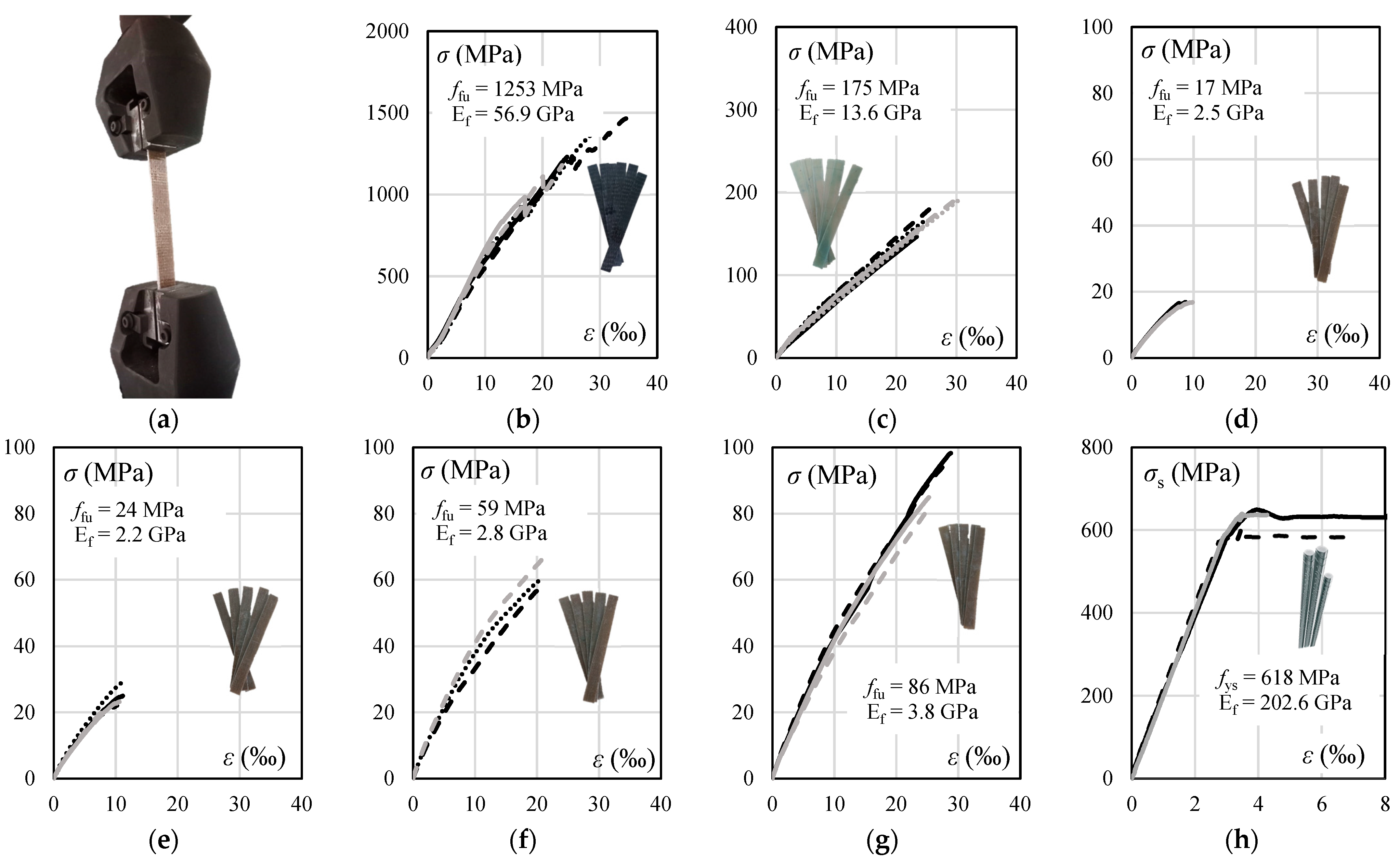
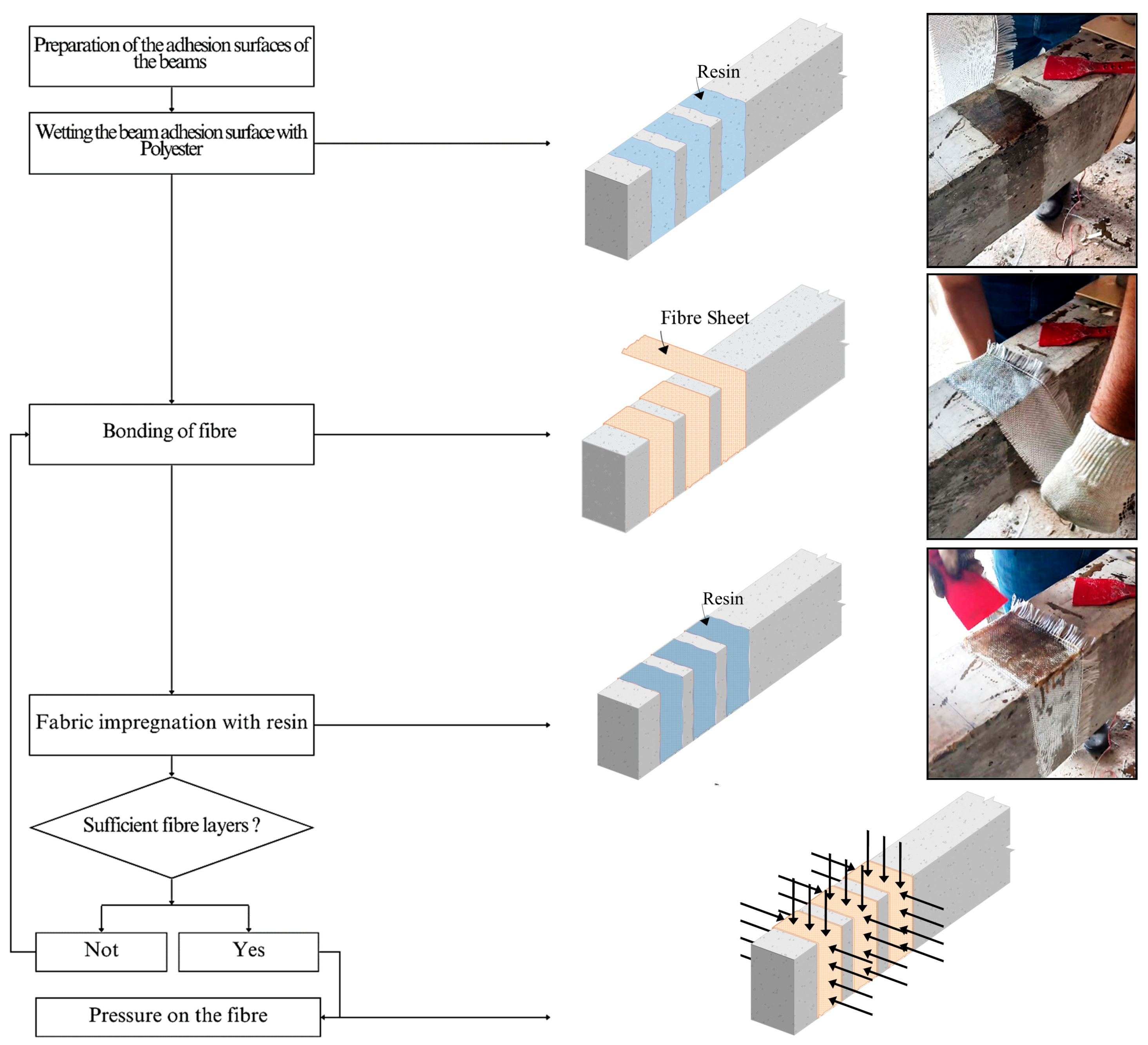


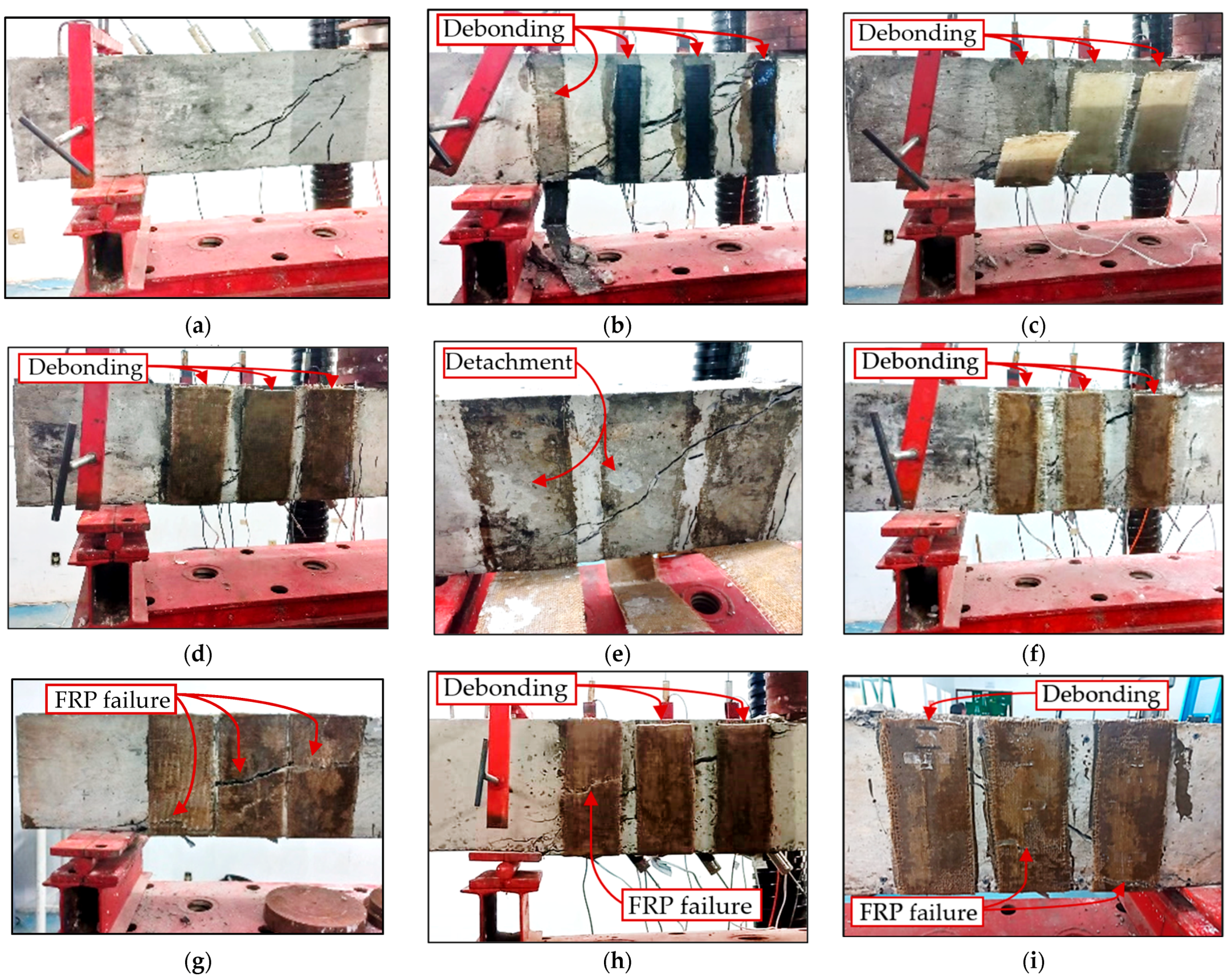
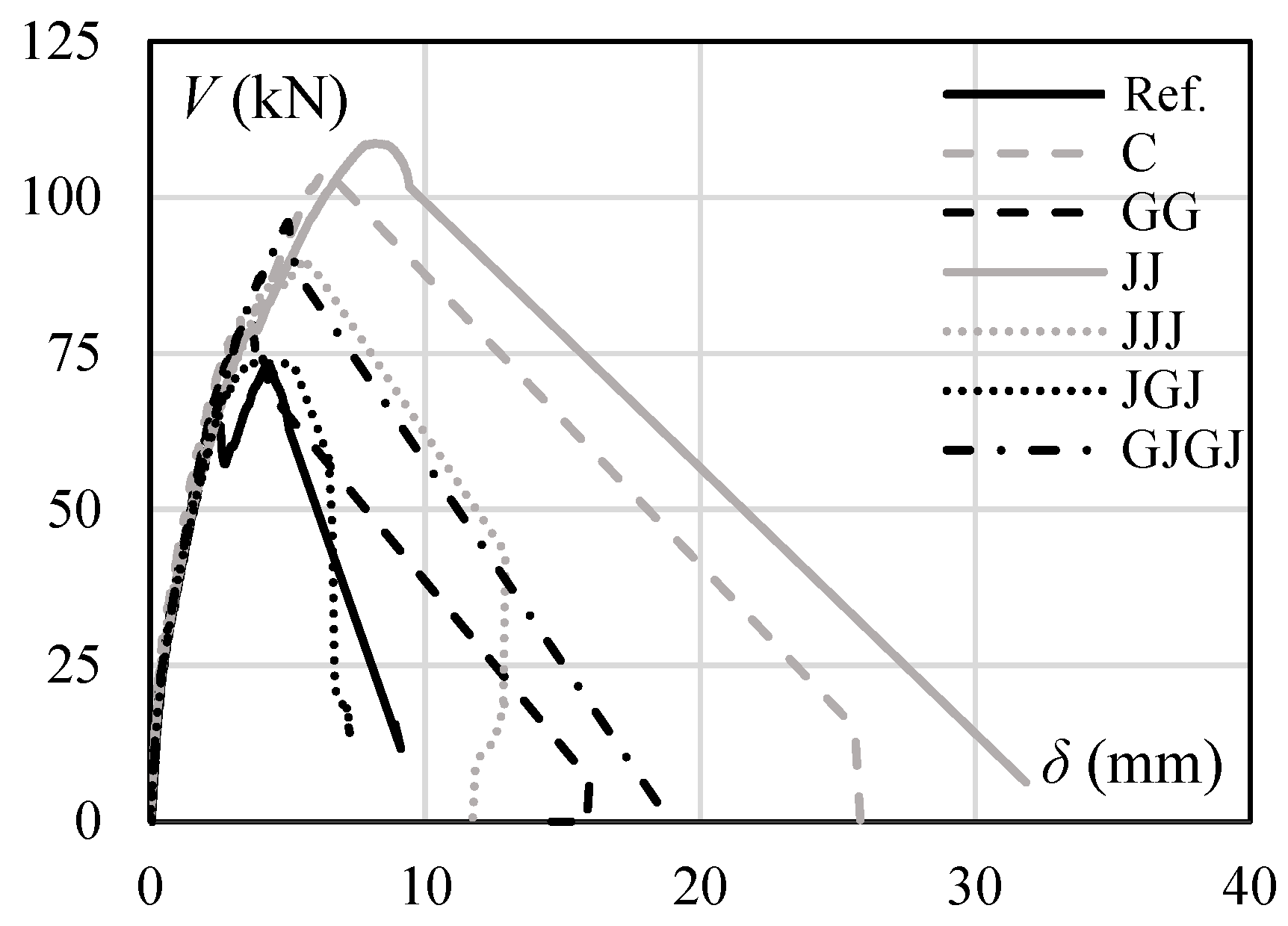

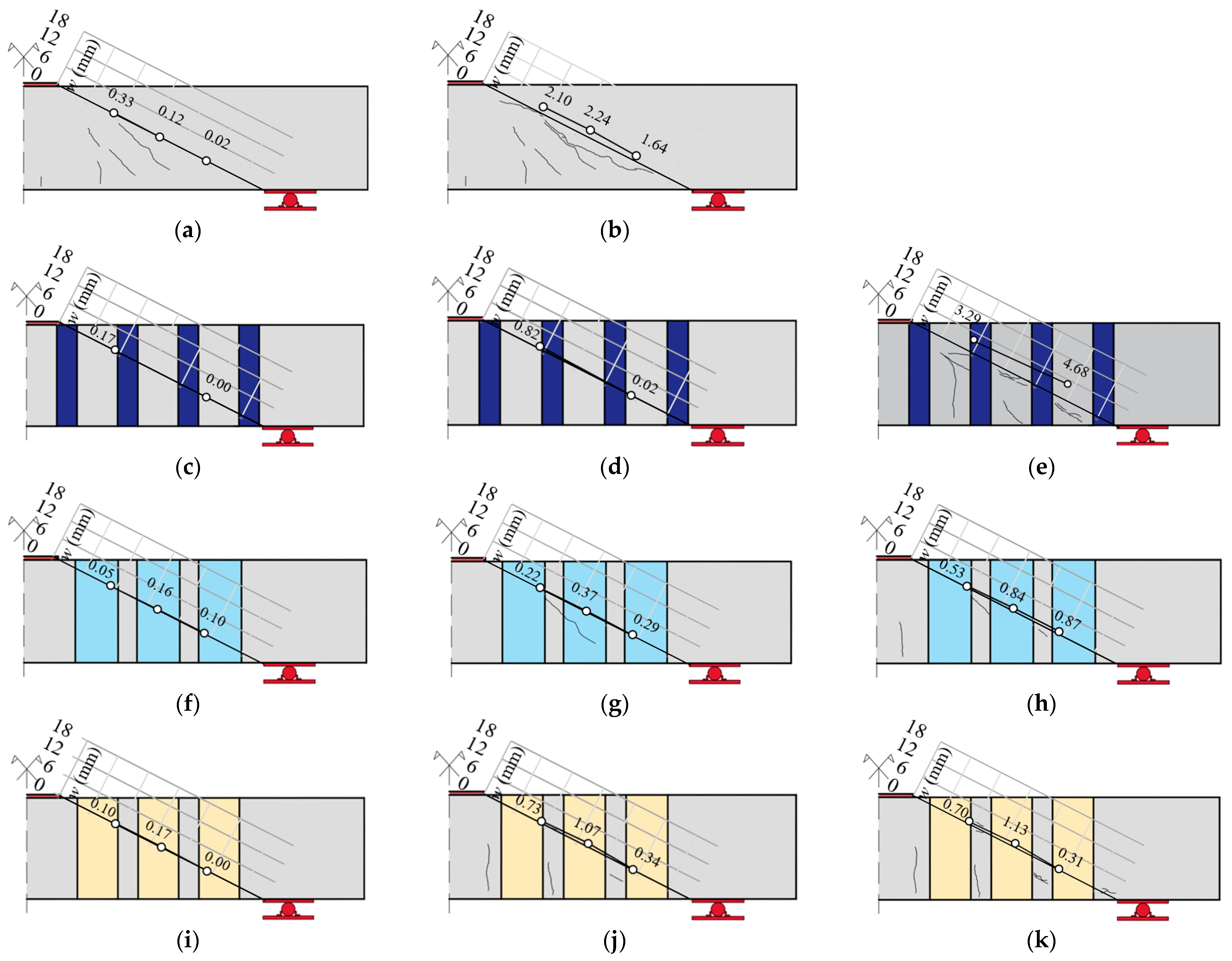

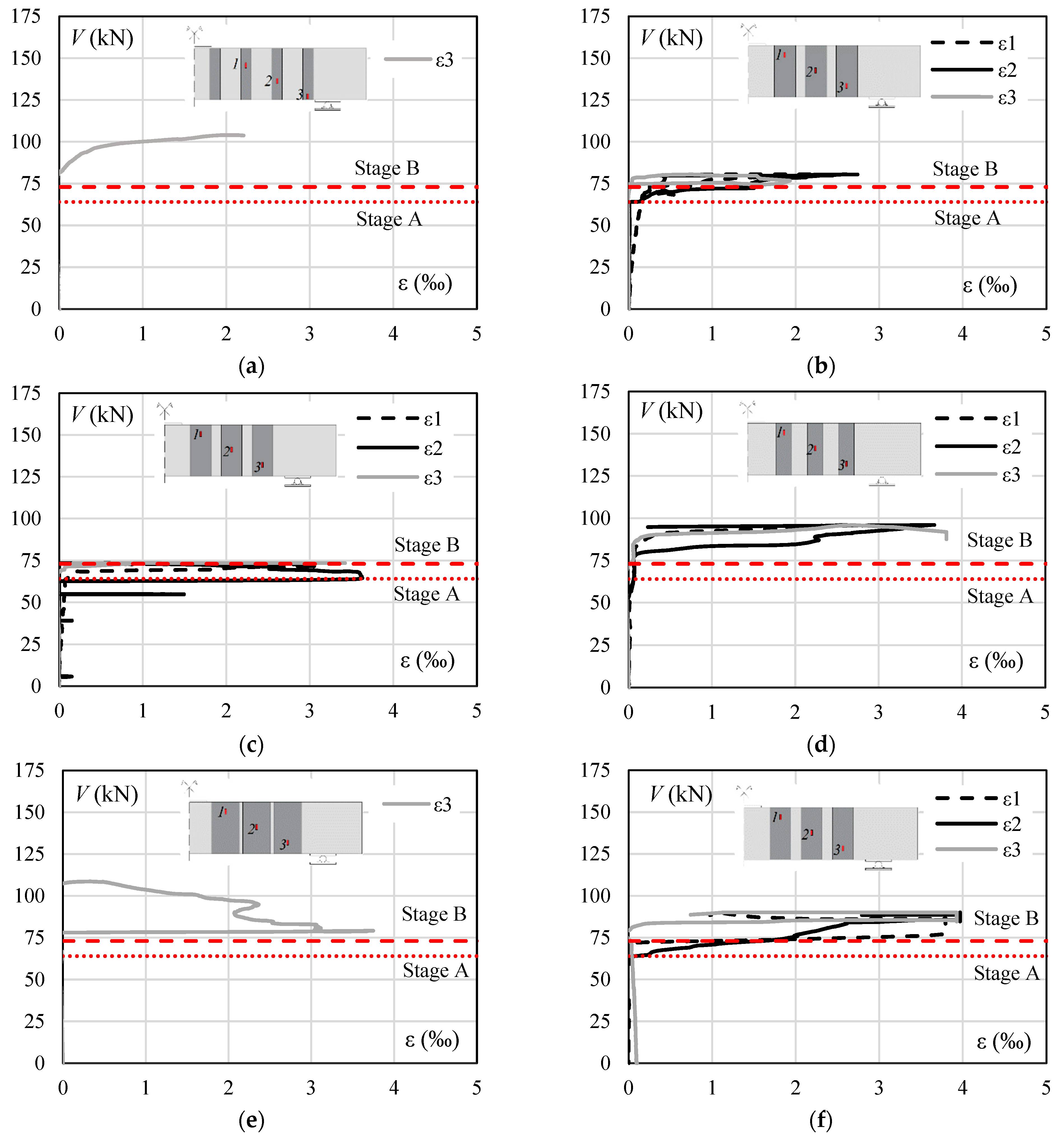



| Equations |
|---|
| Design Code | Equations |
|---|---|
| fib | |
| ACI |
| Beam | bw (mm) | d (mm) | ρ (%) | FRP Characteristics | |||||||||||
|---|---|---|---|---|---|---|---|---|---|---|---|---|---|---|---|
| tf (mm) | CFRP Layers | Vf,C (%) | GFRP Layers | Vf,G (%) | JFRP Layers | Vf,J (%) | FRP layers | Vf (%) | Ef (GPa) | ft (MPa) | wf (mm) | ||||
| Ref. | 147 | 267 | 1.56 | - | - | 0.0 | - | 0.0 | - | 0.0 | - | 0.0 | - | - | - |
| C | 160 | 271 | 1.42 | 0.6 | 1 | 30.4 | - | 0.0 | - | 0.0 | 1 | 30.4 | 56.9 | 1253.0 | 60 |
| GG | 145 | 270 | 1.57 | 0.6 | - | 0.0 | 2 | 30.7 | - | 0.0 | 2 | 30.7 | 13.6 | 174.8 | 125 |
| JGJ | 152 | 262 | 1.54 | 2.4 | - | 0.0 | 1 | 14.8 | 2 | 3.8 | 3 | 18.6 | 2.8 | 58.9 | 130 |
| GJGJ | 153 | 268 | 1.50 | 2.9 | - | 0.0 | 2 | 12.3 | 2 | 6.3 | 4 | 18.6 | 3.8 | 86.1 | 90 |
| JJ | 150 | 271 | 1.51 | 2.4 | - | 0.0 | - | 0.0 | 2 | 14.8 | 2 | 14.8 | 2.5 | 16.7 | 160 |
| JJJ | 161 | 264 | 1.44 | 2.9 | - | 0.0 | - | 0.0 | 3 | 18.4 | 3 | 18.4 | 2.2 | 24.4 | 120 |
| Beam | d (mm) | ρ (%) | Vu (kN) | Vf (kN) | Vu/VREF | Vu/Vflex | ffe.ACI (MPa) | ffe.fib (MPa) | Vu/VR.ACI | Vu/VR.fib | Failure Mode * |
|---|---|---|---|---|---|---|---|---|---|---|---|
| Ref. | 267 | 1.56 | 73.0 | - | 1.00 | 0.66 | 2.05 | 1.51 | S | ||
| C | 271 | 1.42 | 104.0 | 31.0 | 1.42 | 0.91 | 227.6 | 119.0 | 2.16 | 9.56 | S + DB |
| GG | 270 | 1.57 | 80.5 | 7.5 | 1.10 | 0.72 | 54.4 | 16.6 | 1.75 | 12.30 | S + DB |
| JGJ | 262 | 1.54 | 73.5 | 0.5 | 1.01 | 0.67 | 11.2 | 6.0 | 1.58 | 6.14 | S + DB + PCD |
| GJGJ | 268 | 1.50 | 96.6 | 23.6 | 1.32 | 0.87 | 15.2 | 8.4 | 2.03 | 7.58 | S + DB |
| JJ | 271 | 1.51 | 108.6 | 35.6 | 1.49 | 0.96 | 10.0 | 1.6 | 2.31 | 31.33 | S + FRP F |
| JJJ | 264 | 1.44 | 90.1 | 17.1 | 1.23 | 0.81 | 8.8 | 2.3 | 1.87 | 15.84 | S + FRP F + DB |
| μ | 1.96 | 12.04 | |||||||||
| σ | 0.25 | 9.65 |
Disclaimer/Publisher’s Note: The statements, opinions and data contained in all publications are solely those of the individual author(s) and contributor(s) and not of MDPI and/or the editor(s). MDPI and/or the editor(s) disclaim responsibility for any injury to people or property resulting from any ideas, methods, instructions or products referred to in the content. |
© 2024 by the authors. Licensee MDPI, Basel, Switzerland. This article is an open access article distributed under the terms and conditions of the Creative Commons Attribution (CC BY) license (https://creativecommons.org/licenses/by/4.0/).
Share and Cite
Maciel, L.P.; Leão Júnior, P.S.B.; Pereira Filho, M.J.M.; El Banna, W.R.; Fujiyama, R.T.; Ferreira, M.P.; Lima Neto, A.F. Experimental Analysis of Shear-Strengthened RC Beams with Jute and Jute–Glass Hybrid FRPs Using the EBR Technique. Buildings 2024, 14, 2893. https://doi.org/10.3390/buildings14092893
Maciel LP, Leão Júnior PSB, Pereira Filho MJM, El Banna WR, Fujiyama RT, Ferreira MP, Lima Neto AF. Experimental Analysis of Shear-Strengthened RC Beams with Jute and Jute–Glass Hybrid FRPs Using the EBR Technique. Buildings. 2024; 14(9):2893. https://doi.org/10.3390/buildings14092893
Chicago/Turabian StyleMaciel, Luciana P., Paulo S. B. Leão Júnior, Manoel J. M. Pereira Filho, Wassim R. El Banna, Roberto T. Fujiyama, Maurício P. Ferreira, and Aarão F. Lima Neto. 2024. "Experimental Analysis of Shear-Strengthened RC Beams with Jute and Jute–Glass Hybrid FRPs Using the EBR Technique" Buildings 14, no. 9: 2893. https://doi.org/10.3390/buildings14092893





